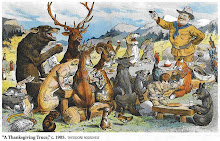If you walk by a pond on a summer evening, you may hear the deep “jug-o-rum” of a bullfrog or the “tung” of a green frog, sounding like a plucked banjo string. Sometimes you’ll hear a whole chorus of frogs, the songs competing with each other for attention.
The frogs are not singing for our enjoyment, of course. Most frog sounds we hear are advertisement calls to attract mates, and the callers are usually males. In some species, these vocalizations also help male frogs maintain territories against other males. If you look closely around the shore of a pond, you often see male green frogs spaced at regular intervals.
Frogs make sound by shunting air from their lungs over their vocal cords, causing them to vibrate. The mouth and nostrils are kept closed. Slits in the floor of the mouth allow air to pass to an expandable throat. In many frogs, the elastic skin of the throat balloons out as a translucent, round sac, or in some species, a pair of sacs. The vocal sac reverberates the sounds, serving as a resonator. Some species, such as the tiny spring peeper and the warty American toad, have external vocal sacs. Others like the bullfrog, our largest frog, have an internal sac; the throat merely swelling when the frog calls.
Songs are quite varied, ranging from the quacking of the wood frog to the musical trill of the toad and the soft, grating snore of the pickerel frog. The differences in pitch, timbre, duration, intensity, and spacing of calls help frogs distinguish members of their own species. The calls also provide information on a frog’s individual identity, reproductive status, location, and the resources in its territory.
Frogs in our region have two basic breeding strategies. Some, such as the wood frog, a brown frog with a black mask that spends most of its time on land, are known as explosive breeders. On the first warm rainy nights of spring, all the sexually mature adults migrate to fishless, often temporary pools. Within a few days, they go through a frenzied courtship, the females lay eggs, and then they all migrate back into the woods. Male wood frogs float around on the surface of the pool, some even sitting on floating sheets of ice, and call to attract females. The first time I heard one of these loud, quacking choruses, I thought it was a flock of ducks.
Other species such as bullfrogs and green frogs are prolonged breeders. Males set up and defend territories in permanent bodies of water. They wait for females to move into the breeding grounds over a period of weeks during spring and summer. In A Guide to Amphibians and Reptiles, author Thomas Tyning describes a territorial skirmish he observed between two huge male bullfrogs: “They were only six inches apart when we first noticed them. Suddenly they lunged at each other; they hung on tightly with their front legs and feet. The water boiled with their activity as they wrestled for half a minute before breaking apart. In another minute they started again … Eventually one of the two frogs took several leaps away. The other followed closely on his heels. The territory dispute was over.”
In both types of breeders, female frogs select mates partly on the basis of call characteristics such as pitch, rate, or length of the call. Females prefer calls that are energetically costly to produce. A male frog that produces these calls shows he has substantial energy reserves and is healthy and vigorous. Females also select a mate based on the quality of his territory and whether it is a good site for egg-laying. Male frogs on the other hand, are not so discerning, says Vermont herpetologist Jim Andrews. He has seen them clasping salamanders, dead mice, and the tops of cattails floating in the pond.
Male frogs assess the threat posed by other males by listening to the properties of their calls that imply bodysize, strength, and willingness to fight. Vocal exchanges between males may precede bouts of wrestling such as the one described between the two bullfrogs.
Male frogs assess the threat posed by other males by listening to the properties of their calls that imply bodysize, strength, and willingness to fight. Vocal exchanges between males may precede bouts of wrestling such as the one described between the two bullfrogs.
Frogs make other sounds in addition to mating and territoriality calls. They will emit an alarm call as they leap off a pond shore into the water to escape a potential predator. The call may startle the predator and warn other frogs. If a frog is caught by a predator or even held by a person, it may emit a distress call — a loud scream (unlike other calls, the scream is produced with the mouth open). A male frog will croak or chirp when in the frenzy of the breeding pool another male clasps it, attempting to mate. This functions as a release call.
You can learn to identify the frog songs in your area by listening to recordings, such as those on Lang
Susan Shea is a naturalist, writer, and conservation consultant who lives in Brookfield, Vermont.











No comments:
Post a Comment